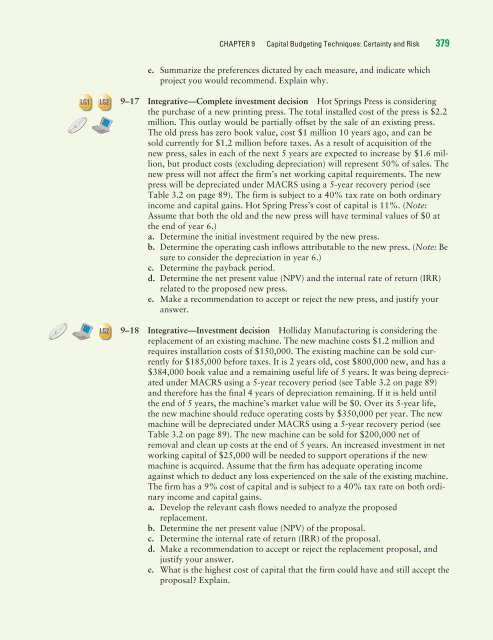Capital Budgeting Techniques: Certainty and Risk
Capital Budgeting Techniques: Certainty and Risk
Capital Budgeting Techniques: Certainty and Risk
Create successful ePaper yourself
Turn your PDF publications into a flip-book with our unique Google optimized e-Paper software.
LG1 LG2<br />
LG2<br />
CHAPTER 9 <strong>Capital</strong> <strong>Budgeting</strong> <strong>Techniques</strong>: <strong>Certainty</strong> <strong>and</strong> <strong>Risk</strong> 379<br />
e. Summarize the preferences dictated by each measure, <strong>and</strong> indicate which<br />
project you would recommend. Explain why.<br />
9–17 Integrative—Complete investment decision Hot Springs Press is considering<br />
the purchase of a new printing press. The total installed cost of the press is $2.2<br />
million. This outlay would be partially offset by the sale of an existing press.<br />
The old press has zero book value, cost $1 million 10 years ago, <strong>and</strong> can be<br />
sold currently for $1.2 million before taxes. As a result of acquisition of the<br />
new press, sales in each of the next 5 years are expected to increase by $1.6 million,<br />
but product costs (excluding depreciation) will represent 50% of sales. The<br />
new press will not affect the firm’s net working capital requirements. The new<br />
press will be depreciated under MACRS using a 5-year recovery period (see<br />
Table 3.2 on page 89). The firm is subject to a 40% tax rate on both ordinary<br />
income <strong>and</strong> capital gains. Hot Spring Press’s cost of capital is 11%. (Note:<br />
Assume that both the old <strong>and</strong> the new press will have terminal values of $0 at<br />
the end of year 6.)<br />
a. Determine the initial investment required by the new press.<br />
b. Determine the operating cash inflows attributable to the new press. (Note: Be<br />
sure to consider the depreciation in year 6.)<br />
c. Determine the payback period.<br />
d. Determine the net present value (NPV) <strong>and</strong> the internal rate of return (IRR)<br />
related to the proposed new press.<br />
e. Make a recommendation to accept or reject the new press, <strong>and</strong> justify your<br />
answer.<br />
9–18 Integrative—Investment decision Holliday Manufacturing is considering the<br />
replacement of an existing machine. The new machine costs $1.2 million <strong>and</strong><br />
requires installation costs of $150,000. The existing machine can be sold currently<br />
for $185,000 before taxes. It is 2 years old, cost $800,000 new, <strong>and</strong> has a<br />
$384,000 book value <strong>and</strong> a remaining useful life of 5 years. It was being depreciated<br />
under MACRS using a 5-year recovery period (see Table 3.2 on page 89)<br />
<strong>and</strong> therefore has the final 4 years of depreciation remaining. If it is held until<br />
the end of 5 years, the machine’s market value will be $0. Over its 5-year life,<br />
the new machine should reduce operating costs by $350,000 per year. The new<br />
machine will be depreciated under MACRS using a 5-year recovery period (see<br />
Table 3.2 on page 89). The new machine can be sold for $200,000 net of<br />
removal <strong>and</strong> clean up costs at the end of 5 years. An increased investment in net<br />
working capital of $25,000 will be needed to support operations if the new<br />
machine is acquired. Assume that the firm has adequate operating income<br />
against which to deduct any loss experienced on the sale of the existing machine.<br />
The firm has a 9% cost of capital <strong>and</strong> is subject to a 40% tax rate on both ordinary<br />
income <strong>and</strong> capital gains.<br />
a. Develop the relevant cash flows needed to analyze the proposed<br />
replacement.<br />
b. Determine the net present value (NPV) of the proposal.<br />
c. Determine the internal rate of return (IRR) of the proposal.<br />
d. Make a recommendation to accept or reject the replacement proposal, <strong>and</strong><br />
justify your answer.<br />
e. What is the highest cost of capital that the firm could have <strong>and</strong> still accept the<br />
proposal? Explain.

















